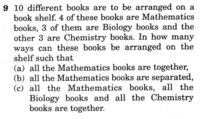So my syllabus has started permutation and combination recently and I seem to understand its basic functions and when to use it until I come across a particular question which goes like this...

Here are the answers

So I got my answer for (a) through the product of 7! x 4!.
But question (b) made me doubt my understanding towards permutation,
So step I, I assume the total arrangement for the other books are 6! since the total of Biology and Chemistry books are 6.
Second step, since the spaces in between the 6 books are 7 in total(including the spaces beside the first and last book) the 4 Mathematics book can be placed in between any of the 7 spaces.
So I came up with, 6! x 7 x 6 x 5 x 4
-6! which is from the other 6 books
-7 x 6 x 5 x 4 which is the space remaining to be filled by the other Mathematics book after the 1st book is placed until the 4th.
The answer I got is 604800.(through calculator)
But its far from the original answer.
I discussed with my teacher and she told me that I should find the total arrangement of all 10 books which is 10! and substract it with the answer I obtained at question (a) which is the product of 7! x 4! (120960).
Now I used this method for other questions and they worked fine for example,

I used the same method and the one my teacher suggested and they both have the same answer.
5! x 6 x 5 (my method)
-5! being the total letters without vowel
-Start with 6 because there are 6 spaces in between 5 consonants(including spaces beside the first consonant and the last)
-6 x 5 being the space remaining after the 1st vowel is filled in between consonants and the 2nd afterwards
7! - 6! x 2!(my teacher's method)
-7! being the total arrangement of all the letters
-6! x 2! being the arrangement if the vowels are together
-6! since 2 vowels are considered one. Thus, instead of 7 its 6.
-2! being the arrangement of the vowels together
Both equations gave the exact same answer which is 3600.
I know I am missing something but I just couldn't figure out what is it and my teacher told me I should just stick to using her method but I wanna know what do you guys think?
Thank you for your time.

Here are the answers
So I got my answer for (a) through the product of 7! x 4!.
But question (b) made me doubt my understanding towards permutation,
So step I, I assume the total arrangement for the other books are 6! since the total of Biology and Chemistry books are 6.
Second step, since the spaces in between the 6 books are 7 in total(including the spaces beside the first and last book) the 4 Mathematics book can be placed in between any of the 7 spaces.
So I came up with, 6! x 7 x 6 x 5 x 4
-6! which is from the other 6 books
-7 x 6 x 5 x 4 which is the space remaining to be filled by the other Mathematics book after the 1st book is placed until the 4th.
The answer I got is 604800.(through calculator)
But its far from the original answer.
I discussed with my teacher and she told me that I should find the total arrangement of all 10 books which is 10! and substract it with the answer I obtained at question (a) which is the product of 7! x 4! (120960).
Now I used this method for other questions and they worked fine for example,

I used the same method and the one my teacher suggested and they both have the same answer.
5! x 6 x 5 (my method)
-5! being the total letters without vowel
-Start with 6 because there are 6 spaces in between 5 consonants(including spaces beside the first consonant and the last)
-6 x 5 being the space remaining after the 1st vowel is filled in between consonants and the 2nd afterwards
7! - 6! x 2!(my teacher's method)
-7! being the total arrangement of all the letters
-6! x 2! being the arrangement if the vowels are together
-6! since 2 vowels are considered one. Thus, instead of 7 its 6.
-2! being the arrangement of the vowels together
Both equations gave the exact same answer which is 3600.
I know I am missing something but I just couldn't figure out what is it and my teacher told me I should just stick to using her method but I wanna know what do you guys think?
Thank you for your time.
